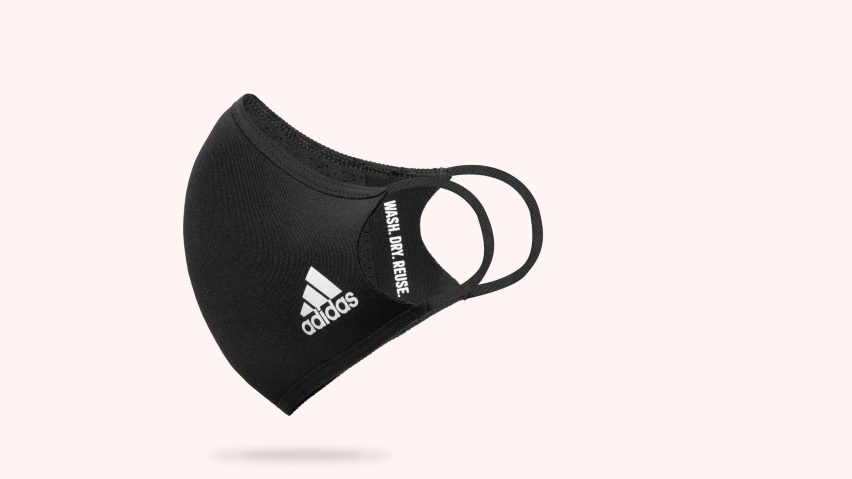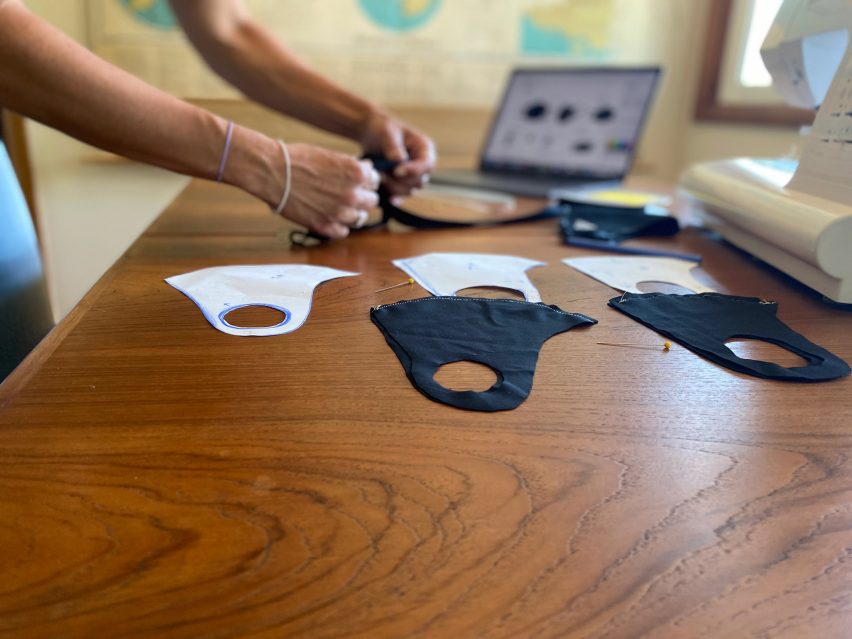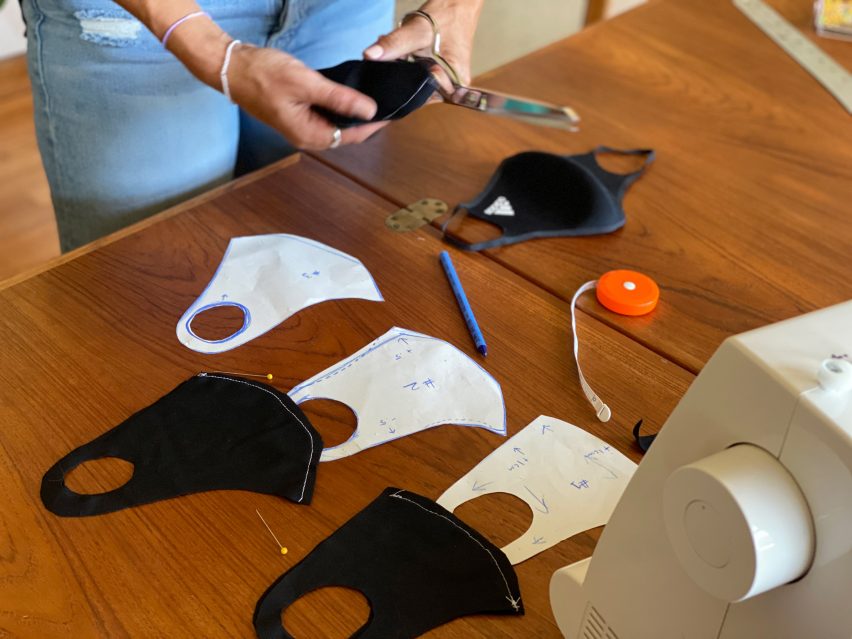
Face Cover "one of the most rapidly produced products we've ever made" says Adidas
Adidas developed its face mask in response to the coronavirus pandemic in less than a month, making it one of the quickest products the sportswear brand has ever made, say its designers.
Adidas released its reusable Face Cover in May in response to the growing demand for face masks from people wanting to reduce their risk of getting or spreading coronavirus.
While sportswear products typically take up to four years to be developed, the face mask was taken from conception, through design and production, and put on sale in less than a month.
"From ideation to production was less than one month"
"The process for the Adidas Face Cover was fast," said Marc Dolce creative director for Adidas' Advanced Concepts team which lead the development of the product.

"The entire process from ideation to production was less than one month. It's one of the most rapidly produced products we've ever made. And created almost entirely from home," he told Dezeen.
"It can take up to four years to bring a new innovation from the brief phase to market, and often just short of two-years for a product or technology update, which is fairly standard across the industry."
The Face Cover was developed by teams, working largely from home, located in cities all around the world. The global collaboration, using cloud-based software, allowed the development process to continue 24 hours a day.

"We're fortunate at Adidas to have teams across every continent, so we were able to structure the project in a way where, when one person finished their day, they could pass the baton to someone else, who was able to pick up where they left off and keep things moving," explained Dolce.
"We relied quite heavily on cloud-based collaborative 3D tools for sharing face scans and concept simulations, which could be worked on by multiple teams in different time-zones."
"We learnt that we can produce new concepts much faster than we expected"
The rapid development of the Face Cover has demonstrated to the company that it can develop products much quicker than it had previously thought was possible.
"I would say one of the main things we learnt was that we can produce new concepts much faster than we expected or previously considered," said Ashley Anson, design director of apparel for Adidas' Advanced Concepts team.
"We've worked in expedited processes for some past projects, but Face Cover definitely helped reset our feeling of how quickly we can deliver, communicate and distribute a new product concept," she told Dezeen.
"There is an opportunity to react to athlete and consumer needs in real-time"
This rapid development speed could allow the sportswear company to create products for both athletes and consumers quicker than it has in the past.
"The Face Cover shows us that there is an opportunity for us to react to athlete and consumer needs in real-time – that's quite exciting when you think about matching it up with data-informed tools," explained Anson.
"Moving forward we'll continue to challenge ourselves further to work faster and even more efficiently in unpredictable and moving situations."

However, Dolce warned that in the majority of cases developing new products will still be an in-depth process that will take time.
"Our regular development process is built on concepting, testing and validation," he said. "Developing innovation and quality assurance can and should take time; you can't rush through materials, fit and construction and expect to make a great, functional product."
"This project taught us a lot about how quickly we can adapt and pool resources to bring ideas to life, in time-pressured situations that need to respond to a very specific need or requirement," he continued.
Read below for the full interview with Marc Dolce and Ashley Anson.
Tom Ravenscroft: How long did it take to develop the face cover and how does this compare to the time it takes to bring other items to market?
Marc Dolce: It can take up to four years to bring a new innovation from the brief/insight phase to market, and often just short of two-years for a product or technology update, which is fairly standard across the industry.
The process for the Adidas Face Cover was fast. The entire process from ideation to production was less than one month. It's one of the most rapidly produced products we've ever made. And created almost entirely from home.
As soon as public health groups in many countries started recommending some form of face covering, we felt there was a need for a comfortable and reusable non-medical cover as people returned to their communities. So, we immediately started sketching, making and prototyping, all from home.
We also developed a rapid prototyping and production process together with our factory development team, who were able to create mock-ups overnight, which we reviewed during video calls each morning to refine the look and fit.
Tom Ravenscroft: How did the development of the face cover differ from the usual development cycle at Adidas?
Marc Dolce: It was an accelerated version of our regular development process. We quickly assembled a working group with different reps from across the brand, including designers, engineers, marketers and many more to help drive the work.
Ashley Anson: We shared the brief with the entire Adidas design group to gather ideas and input – to take advantage of team expertise in supportive apparel, fit, breathability and sustainable materials.
Once the design was finalised, the initial prototyping and pattern creation were all done from home in a couple of days – and we ran the expedited development process, working virtually with the factory to bring it to life as quickly as possible.
For a design project in more normal circumstances, we may have travelled and worked collaboratively with developers on materials, fit and construction in person. The biggest change was that the entire process was done from home – we adapted and held all of our meetings virtually, working through new prototypes each day to get the face cover to a place where we wanted it in as short a time as possible.
Tom Ravenscroft: What was the biggest challenge of getting this product ready for release in such a short time-scale?
Ashley Anson: The biggest challenge was getting the fit and sizing right without some of our testing facilities available, and making the development happen against our one-month timeframe, all within the constraints of the situation.
The material selection sessions were held virtually, and team family members helped out with initial fittings.
Working with our factory development partner was also challenging in that they also had to adjust their processes for this project, with many developers also working and coordinating from home. Running a refinement process remotely in this way was completely new territory for us.
Tom Ravenscroft: Why do you think the team was able to design, develop and produce the item in such a short time?
Ashley Anson: Having to adapt our processes to tackle all the things we'd do normally, but at pace and from home, created a new set of parameters and focus for us to work speedily and efficiently.
The entire working group – including the folks from design, development and marketing – all knew that we had to bring this to life as quickly as possible.
Marc Dolce: We're fortunate at Adidas to have teams across every continent, so we were able to structure the project in a way where, when one person finished their day, they could pass the baton to someone else, who was able to pick up where they left off and keep things moving.
We relied quite heavily on cloud-based collaborative 3D tools for sharing face scans and concept simulations, which could be worked on by multiple teams in different time-zones.
With everyone focused and working together on their respective component parts, it all got done through a shared ambition and goal.
Tom Ravenscroft: Did the development of the face cover expose the fact that Adidas' standard development time is too long?
Marc Dolce: The Face Cover was a collaboration across all of our brands: Adidas sport, Adidas Originals and Reebok. It showed us that we can all work together very quickly and efficiently and that we can see every obstacle as an opportunity.
Our regular development process is built on concepting, testing and validation. Developing innovation and quality assurance can and should take time; you can't rush through materials, fit and construction and expect to make a great, functional product. This project taught us a lot about how quickly we can adapt and pool resources to bring ideas to life, in time-pressured situations that need to respond to a very specific need or requirement.
Tom Ravenscroft: What impact do you think coronavirus will have on how companies develop new products?
Ashley Anson: Navigating this project during the pandemic has shown us that we can be even more efficient and connected in the way we approach a brief from beginning to end.
We also have a refreshed perspective on the creative and development process, and how this can be done with more teams across more locations in the future. We had to adapt some of our key meetings: initial creative exploration, concept and sample reviews, with all taking place virtually.
In many ways, I'd say that working in this way has made us even more connected to teams in other locations across the world, as the very implication of remote work means you have to figure out how to work together and see/speak to each other both informally and formally.
I believe we'll take all of this into our physical office and workshop settings, but distance will definitely no longer be a deterrent to collaborating even more productively across the world.
Tom Ravenscroft: What has Adidas learnt from the fast-paced development?
Ashley Anson: I would say one of the main things we learnt was that we can produce new concepts much faster than we expected or previously considered. We've worked in expedited processes for some past projects, but Face Cover definitely helped reset our feeling of how quickly we can deliver, communicate and distribute a new product concept.
Marc Dolce: Approaching a less-than-six-weeks brief was a unique challenge for a team like Advanced Concepts, where our remit is to work two to four years into the future. With this level of focus, we can streamline processes, working models and create digital and physical prototypes in a matter of hours when needed.
We felt the Adidas #hometeam and #readyforsport campaigns were more than just that, rather they represented the mood within the company throughout the crisis: supporting each other and getting things done, with a hopeful eye on the future. We tried to bring this spirit into the way we approached the Face Cover project.
Tom Ravenscroft: How will it impact the company?
Ashley Anson: The Face Cover shows us that there is an opportunity for us to react to athlete and consumer needs in real-time – that's quite exciting when you think about matching it up with data-informed tools. Moving forward we'll continue to challenge ourselves further to work faster and even more efficiently in unpredictable and moving situations.
For Face Covers, we're currently exploring what a next-generation could look like and how it should function. We're looking into a focus on sport and performance to help keep the athlete protected and comfortable during physical activity. We'll hopefully be sharing more soon.